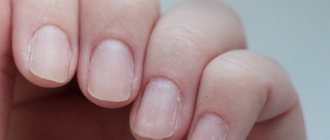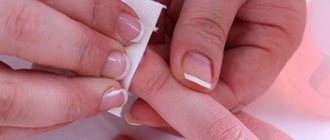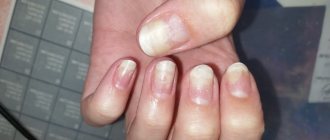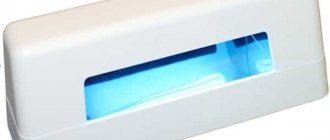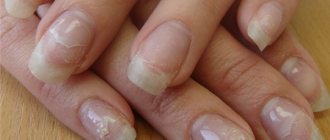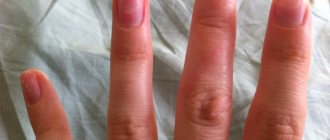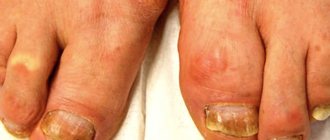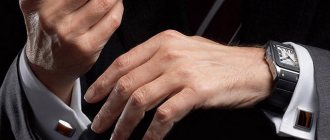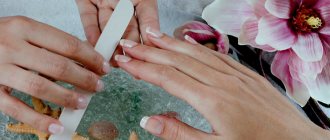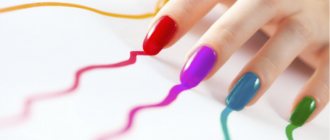Gel polish has long been a game changer. With the advent of super-resistant coating, few people worry about chipping, and the few fans of classic varnish immediately became old believers. Quarantine gave us the opportunity to admire the condition of the nails after the gel in all its glory - the plate from it becomes twice as thin, and aggressive removal leaves a mark in the form of cracks and unevenness. There is good news: nails, like hair, can grow back to their previous healthy appearance with proper care. Which one exactly? Read the material.
Disadvantages of manicure with gel polish
First of all, you need to consider that any nail coating, be it regular polish, gel or acrylic, is a polymer. That is, a chemical substance. Gel polish, according to its chemical structure, is a polymer coating. And covering the nail plate, this coating prevents the nails from breathing.
Before applying gel polish, the nail is polished, as a result of which its nail plate becomes thinner over and over again. As a consequence of this, after 4-5 procedures, the nails become not only thin, but also fragile, their delamination and cracking appear.
The procedure for a gel polish manicure is quite complex and requires a certain level of professionalism. Therefore, a manicure done by a non-professional, with poor-quality treatment of the nail plate before applying gel polish, can cause the development of infection and the appearance of inflammatory processes under the coating.
The procedure for removing gel polish coating, which cannot be done without liquid with acetone, also has negative factors. Which additionally dehydrates the nails (and with them the skin around them). Often, women themselves remove gel polish by simply peeling it off their nails, not realizing that the top layer of the nail plate is also removed along with the coating.
How to care for your nails after removing gel polish. The main problems of nails after gel polish
Nails become thin after using gel polish because the dorsal layer is very thin. Each time shellac is removed, the cells of the dorsal layer are removed along with the polymer, despite the fact that the nail has not yet grown in length and has not been renewed.
A complete change of the plate occurs at intervals of 4 to 6 months, and visits to manicurists once every three weeks. Based on these data, we can conclude that cell renewal does not occur as quickly as we would like.
Common problems after using polymer:
- The structure of the plate changes, it becomes rough, soft and thin.
- From the middle of the nail, separation begins due to the fact that the cells do not have time to divide and differentiate.
- If the integrity of the plate is violated, the densely packed horny scales begin to die off, forming a wavy surface.
- Increased sensitivity of wounded marigolds to cold and hot water.
About a quarter of girls face these problems. This is mainly due to the fact that the thickness of the plate becomes thinner with each removal (especially when craftsmen use a metal pusher) and new coating.
If damage is caused to the matrix zone (the white hole near the cuticle), the consequences can lead to hyperkeratosis of the nail bed. This is a terrible disease that completely affects the nail. Therefore, today manicurists do not file down the nail plate, but use primers and bonders to coat with gel polishes.
Causes of nail damage with gel polish
If the master follows the correct technology for working with gel polishes and the client wears the coating for no more than 3 weeks, damage to the nails is unlikely. But if the condition of the nails still worsens, something clearly went wrong. Let's look at the possible reasons.
Poor quality gel polish
The durability of gel polish is provided by methacrylic acid, which is contained in the polymer coating. The higher the content of acid and harmful impurities, the more pungent the smell. The more acid in the composition, the more aggressive the effect on the nails. Too much methacrylate in the composition dries out the nail plate, making it very fragile and brittle. In this case, the coating usually holds up well, but over time the nails simply begin to crumble.
Unprofessionalism of the master
For example, an inexperienced master can “saw” his nails, and they will become thin and brittle. In addition, some craftsmen, while advertising the durability of their coatings, use gels containing too high a percentage of methacrylic acid and other harmful substances.
Mistakes when performing a manicure
When processing the cuticle, damage and thinning of the nails is also possible, especially with hardware manicure. Damage to the matrix is very dangerous, because it can lead to irreversible damage to the nail.
Removing gel polish coating using liquid
All gel polish removers contain acetone. And even if it is written on the bottle that the product does not contain it, this means that it does not contain acetone, but some of its derivatives. It is obvious to everyone that micellar or violet water will not dissolve the polymer. Acetone dries both nails and skin, so it is better to remove the coating using a manicure machine. But it is important that a competent master does this.
“Over-wearing” of the coating
Clients often boast about the professionalism of their manicurists, showing each other their regrown coating: “Look how long it lasts, look how much it has already grown.” The recommended period of wearing gel polish is 2-3 weeks. Manufacturers usually recommend 2 weeks, because... Afterwards, the material ages and the coating begins to peel off.
Wearing the coating for too long can lead to breakage of the overgrown nail. The nail may break inside the covering into the meat. This is not only painful, but also dangerous, since it is fraught with infection and the development of an inflammatory process under the nail. In such a situation, you must immediately go to a specialist and remove the coating.
So-called “detachments” are also dangerous. They are a favorable environment for the growth of fungus and bacteria, which can lead to serious nail diseases. Frequent, prolonged contact with water contributes to the appearance of detachments, so it is recommended to do homework with gloves. Regular visits to the sauna, swimming pool, trip to the sea, etc. - all these are reasons to change the coating more often than once a week to avoid detachments.
Every girl should know
It is worth remembering that gel polish is a coating that combines the properties of varnish and gel. It is applied like a varnish and dried like a gel under an ultraviolet lamp.
In order for the manicure to last a long time, the products for proper nail care with gel polish must be of high quality.
Contact a responsible craftsman who values his reputation and strictly adheres to application technology.
In rare cases, there is an allergy to gel polish. It manifests itself in the form of swelling of the fingers, burning, and redness around the nail.
Photo: appearance of healthy nails
But this happens if you use a base that is too cheap or a top coat of dubious origin.
It is advisable that the base and top coat be of the same brand, and that the coating be fresh, since the old gel thickens and air bubbles form in it.
As a result, the coating lays down unevenly and peels off quickly. There are a few more rules for good nail care with gel polish, which are worth examining in more detail.
What our marigolds don't like
Nails do not like hot water and aggressive chemicals. Therefore, when washing dishes, cleaning the floor, cleaning the stove, cleaning the bathroom, and carrying out other household work related to cleaning, only wear rubber gloves.
This will extend the life of the coating by several days. Wearing gloves while cleaning is a good habit.
It helps keep the skin of your hands in excellent condition. Toxic substances that can cause allergies do not penetrate the skin, while gloves protect the skin and nails.
Although it is known that nails are keratinized cells without blood vessels and nerves, this does not mean that they do not need to be looked after.
Photo: cleaning gloves
The surface of the nail can undergo mechanical damage, and under the influence of acids it can become cloudy, change color, and collapse. When nails are not straight, have lost their shine and strength, this is immediately noticeable.
The nail plate is not very sensitive to oils and creams. But the cuticle that surrounds the nail requires careful care.
Massage your fingers with castor oil or use special cosmetic products aimed at skin regeneration.
We must not forget to use oils and gels for the feet, because the toenails must also be in perfect condition.
Nails absorb water well, so with frequent contact with water, they become softer and thicker. The shine of the nail comes from inclusions of fat and water in its structure.
The condition of nails is greatly affected by a lack of vitamins, amino acids, and minerals. Marigolds especially suffer when they do not receive enough protein, sulfur, zinc and phosphorus.
Products containing vitamin B2
It is necessary to include sea fish, eggs, fermented milk products, and vegetables in the diet. Proper balanced nutrition will soon make itself felt - the condition of the skin and nails will improve.
Manicure mistakes
In any process, the sequence of actions must be strictly followed in order to obtain an excellent planned result.
Applying gel polish does not deviate from this rule. The main mistakes that beginners make:
- improper preparation when the edge of the nail is uneven and not smooth enough
- using a polisher instead of a buff
- applying cuticle oil immediately before the gel
- application of acid primer
- applying too thick a layer of gel
- using too much base
- shaking the bottle of gel, which leads to the formation of bubbles.
Separately, it is necessary to say about the buff. It is used to create a slightly rough surface. The gel polish adheres well to it and holds securely in the future.
If you use a polisher, the effect will be completely opposite. When working with a buff, do not overdo it.
Just two or three movements are enough to get the desired roughness. Why can't you apply oil, while general nail care with gel polish is approved?
Just like polisher, it reduces adhesion. The gel simply won't stick. Instead of oil, use a dehydrator or fresher.
As a result, the surface is degreased and the gel adheres firmly to the nail plate. A jar of varnish should not be left open. It’s not for nothing that they make it with an opaque coating.
From exposure to sunlight and lamp lighting, the varnish dries out and becomes unusable. The gel must be dried thoroughly by positioning your hand correctly under the lamp.
It is best to dry each nail separately, but to save time, do it differently. Only the thumbnail is dried separately, while the rest are placed in the center of the lamp.
How to save damaged nails?
First of all, you need to know that a dry, cracked nail will no longer be saturated with new strength and will not recover. Even if you give it a “rest” for two to three weeks from any decorative coatings. The only way to restore a damaged nail is to grow it again. This will take 2-3 months and the following procedures must be completed.
Trim the length
If the nails are damaged, it is best to cut the length, leaving a free edge of the nail no more than 1 millimeter. This will avoid the occurrence of additional cracks and chips, and will also speed up the process of restoration of the nail plates.
Trim your nails in a straight line. The corners of the nails should form a right angle, which can be slightly rounded using a glass nail file. This will prevent ingrown nail plates.
Don't forget to hydrate
Your nails are the same skin, just with a slightly different structure. Therefore, they also need moisture. To do this, it is enough to keep your fingers in warm water for 10-15 minutes every evening. Don’t forget about brewed medicinal herbs - infusions of chamomile, calendula, oak bark, and St. John’s wort will work perfectly.
If desired, you can add sea salt or lemon juice, which strengthen the plates well, promoting growth.
Do oil baths
For healthy growth and beautiful appearance, nails and hand skin need not only to be moisturized but also nourished. Oil baths restore the nail bed after injury, detachment, or dystrophy.
The main component of the bath solution is base vegetable oil. We use any oil: castor, almond, olive or coconut, which we heat in a water bath and dip our fingertips into it.
For best results, add a few drops of oil solutions of vitamin A (if you are not allergic), E or essential oils. To prepare an oil bath, you will need 1/2 cup of oil and about 5 drops of additional ingredients.
After the procedure, do not wash your hands, but blot them with a napkin. Rub the remaining oils into your fingertips with massage movements, this stimulates nail growth and allows you to prolong the effect of nutrients. I recommend doing these baths once a week.
Use strengthening agents
There are many nail strengthening products available on the market, used at different intervals. Some of them are applied daily, others every three days. You should choose the form that will be used “without absenteeism.”
For nails with grooves and a ribbed structure, strengthening bases are suitable for smoothing the relief; for those that have changed their color (without signs of infection), use whitening compounds; for dry and thin nails, use rich nutritional compounds.
Use nail hardeners
If the nails are very thin and brittle, peeling, they require more intensive care. Namely, the use of hardeners. They can be found in professional stores or purchased at a nail salon.
Such products nourish the nail plates well, even if they are severely damaged. The best options can replace several products at once: base, clear varnish and repair agent. They are easy to use: apply to your nails and wait until dry. You can apply decorative varnish on top, but in case of severe damage to the nails, this is not recommended.
Take care of your cuticle
While carefully caring for the plates, many people forget about the cuticle, but the health of the nails and their growth largely depends on the condition in which it is. First of all, you don’t need to trim the cuticle - there is a risk of infection. It is best to push back the skin at the base of the nail with an orange stick after a relaxing hand bath or bath or shower.
Lubricate your cuticles with a natural oil of your choice every night before bed to give them time to soften and nourish overnight. But that's not all - after the oil has dried, you should apply a moisturizer on top to seal the results. And since we have taken a course on natural ingredients, you can use regular sour cream for these purposes. This will create a "glove" effect that will protect and restore softness to your cuticles while you sleep.
Protect your nails from water and chemicals
If there is damage to the nails in the form of cracks or delamination, then all “wet” housework using detergents and chemicals should only be done with gloves.
Review your diet
The beauty and health of nails are directly dependent on the quality of nutrition. To keep your nails healthy, you need to eat healthy foods rich in vitamins or drink special complexes. B vitamins must be supplied to the body. Their lack causes darkening and brittleness of nails.
Vitamin A supports skin protein fibers and restores nail structure. Vitamin E increases elasticity and helps fight delamination. Zinc deficiency makes nails weak and brittle, and white spots may appear. Omega-3 acids are also essential for healthy nails.
Dairy products, carrots, broccoli, red fish, turkey, whole grains, and nuts will help fill the deficiency of vitamins and useful elements.
Limit the consumption of fatty, spicy foods, and alcohol. They disrupt digestion, impair liver function, which negatively affects the condition of the nails.
Between manicure/pedicure sessions YOU CAN:
- not advisable, but you can file your nails if they are in the way or one is broken. This will not immediately deteriorate a high-quality coating, but it will not last for a long time, so proceed carefully;
- Once a week, gently push back the cuticle with an orange stick, and then apply moisturizer. This way, it grows noticeably less actively and gets used to moving away, which means it will be easier to remove during a manicure. This is especially true for girls with cuticle sticking to the plate;
- nourish your hands with good cream and oil. The main thing is not to apply them a day or two before the session.
| Sign up | Prices | Stock |
Everything you need to know about manicure and gel polishes: interview with the owner of the Ananasnails studio
The beauty industry is moving forward by leaps and bounds, but this makes it increasingly difficult for us, ordinary consumers, to understand what is happening around us. There are so many legends and myths about gel polishes, and when we come to the salon, we are often faced with the ignorance of the masters and our own modesty, so we decided to deal with the topic of nail coating and asked the founder of the Ananasnails manicure studio, Olga Panasenkova, to answer the most frequently asked questions.
Can gel polish ruin your nails?
No, only the wrong technology can ruin your nails. The option of removing by soaking may not be suitable for a person, the solution itself may not be suitable for the brand of coating, and an acetone-containing liquid can be very harmful. As a result, a person simply “burns” his nails, the nail plate shrinks, turns white, and then his hands begin to hurt. Ideally, it is better to remove the gel polish with a device to the base (as when correcting extended nails), leaving a thin layer of it on the nail without damaging the nail plate. If you need to remove it down to the nail, then soak it in a liquid without acetone for no more than 3-5 minutes, this is enough for the base to gently peel off from the nail and for the plate not to be damaged by metal pushers. This is for those who don't want to cover it. If after removal the client plans to make a new coating, then the base can not be soaked, but left in a thin layer. Since the base does not age, when a new layer polymerizes, they simply combine. This does not injure the nail itself, especially if it has been damaged before. If they wrap your nails in foil along with the color, scream and ask them to file them down to the base. If the master does not have a machine, then this can be done even with a file; there are hard buffs, after all. You cannot remain silent about this if you value your nails.
Removal by soaking is harmful due to the acetone in the composition, which dries out the nails, they begin to flake and crumble. All liquids work differently, usually they loosen the gel polish and it comes off well. You cannot keep the solution for more than 5 minutes, because it may cause a chemical burn. Sometimes the master asks you to sit for half an hour, but this is absolutely wrong. They ask you to tell me when it will burn. But it shouldn’t burn! This is already a chemical burn, and depending on your sensitivity, these will be different stages.
Now there are a lot of cheap removers on the market, as well as gel polishes themselves. Many cause allergies and burn the nail plate in combination with a powerful lamp. But the method of removing by soaking is a thing of the past; it is suitable only for those who want to take breaks and restore their nails after drying out.
By the way, about allergies. Are there any contraindications for gel polishes? What could be the consequences? Gel polish itself is not harmful; the compositions are almost the same for all. There are several Chinese brands to which you may be allergic due to one component. There are absolutely hypoallergenic coatings like CND; now many good Russian brands produce high-quality products. The base should be good, and what brand of color you use is not particularly important. As for the quality of the color itself, it does not affect the nail plate in any way, it is only the appearance.
Sometimes craftsmen use cheap materials and fakes and perform the procedure incorrectly. Some aggressive drugs cause onycholysis. The nail moves away from the nail plate, and huge voids appear. In this case, you should not apply any gel polish. You need to take a long break for treatment. Sometimes masters, in pursuit of money, do not talk about the onset of onycholysis and cover their nails. But it doesn't work that way. Ideally, the master should not persuade a client with injuries to have a coating; it is better to advise a good doctor and check his health. Sometimes nails are an indicator of disorders in the body; you should immediately go check your kidneys, liver and other organs.
What types of manicure are there? Which one is better to choose? How do they combine with gel polishes?
There are classic, hardware and combined with cutting with scissors or nippers. The latter is the most modern type of manicure, because the master sees on dry skin where the dead skin cells end. This is an advantage to do the procedure without any cuts or damage. With a classic manicure, the cuticle soaks and turns white; if it is thin, you cannot avoid cuts. Hardware manicure is much better, the main thing is to take care of the attachments and clean them, but this is the responsibility of the master.
A classic manicure can be done before coating, but it is worth considering that gel polishes do not behave very well with water. We soak the old coating before applying a new one, do a manicure using water, and then degrease everything with alcohol wipes or dehydrators, but this additionally dries out the nail plate. Therefore, it is easier to do a hardware manicure on a dry surface, and here you will immediately understand that the skin is not damaged. Of course, here everything depends on the master and his skills: you can cut down a lot with the device, you can harm the client if you don’t know how to work with attachments. It all depends on the experience, diligence of the master and conscientiousness.
What is alignment and why is it needed?
Nowadays, almost everyone straightens the nail plate using gel polishes. This is the creation of the ideal nail architecture. All flaws are hidden with gel polish, a smooth surface is created, but quite a lot of base is used. If there is not enough of it, alignment will not work. Liquid bases can be used to level the nail plate, but this is not suitable for thin and brittle nails.
Often people ask to seal the end, but this makes no sense. The very first thing where the gel polish starts to fall off is the end, it gets touched and the gel polish starts to fall off.
How long can I wear gel polish and how often can I reapply it?
You cannot overuse gel polish, as detachment may occur. Water, foundation, food, anything can get under the coating. And germs can multiply. It is better to make corrections once every 3-4 weeks, but not less often, no matter how well the coating lasts. There may also be a greenhouse effect. If you use the classic removal option, then try to renew the coating not very often, otherwise you will dry out the nail plate. I have clients who go once every 10 days because they are annoyed by the appearance of the overgrown nail, but I only remove it with a device. We paint under the cuticle, carefully lifting it, but some nails grow quickly, everything is very individual.
Do I need to “rest” from gel polishes? Are breaks beneficial?
A break makes sense if you remove gel polishes with your teeth, hands and other unconventional methods, injuring your nail. You need to rest wisely, doing useful things for the body, for example, salt baths with oils. You can also rub in wax. The nail itself, its visible part, is dead cells. You need to nourish from the inside, a growing nail gets everything it needs from the nail bed, so it makes sense to take a course of vitamins, do paraffin therapy, use oils and care.
A good procedure for brittle nails and peeling is IBX: the product penetrates the very structure of the nail, it is something like nail lamination, it eliminates chips and glues the layers together. IBX can be done under coating. This is a good option if you had a bad removal done, but you don't want to go without color on your nails.
It takes at least 6 months for a nail to fully recover. And the master should not persuade you to cover it with something; a good master will simply offer to carry out the care procedure. If you go to the same nail technician for years and do not use aggressive removal products, then your nails will be fine and they are unlikely to need rest. You only need a break from a bad master and salon.
Is it possible to restore nails with gel polish?
It all depends on the problem. If your nails are thin, then they will feel good under the coating, but again, you cannot remove them with liquid, so as not to dry them out and injure them. It is better to change the coating more often, ask not to file the nail plate itself, and use only a soft buffer to level the base. Gel polish can help restore by protecting the nail plate from mechanical damage.
Sometimes people ask to add acrylic, but it doesn't restore anything, it just makes the nail stronger. A very good option if, for example, there is flaking at the ends. We do acrylic every other time because it stays in the base and we don't want to overload the nails.
What should you pay attention to when choosing a salon and specialist?
On the purity of the work, the presentation of the master, his development. If you look at the work, glare is an important indicator. The highlight shows the architecture of the nail, it should be oval and beautiful around the edges. If it is round, then the material is heavily piled up. If it goes crooked, it means the alignment failed. You can look at the end of the nail to make sure it is even. The highest point of the nail, the apex, should be truly the highest and taper off towards the edges. Each master has his own style, some make the coating thicker, some thinner.
It is worth paying attention to the appearance of the master, his concern for health: does the master use a spray for disinfection, a vacuum cleaner so as not to breathe dust, a mask, gloves, sterile instruments. If a person smells unpleasant or something is wrong, run away from such a salon. The master should look well-groomed and clean.
Can a master cheat with the sterility of instruments?
Tools must be in a craft bag of an air or steam sterilizer. We treat ours with air; within an hour, the instruments are treated with heat of 180 degrees. A logbook is kept. As for cheating, you can't be sure because sometimes the experts fry empty bags. In unscrupulous salons, the master may have only one set of tools, which he washes with water and alcohol spray and returns back to the bag. It's a matter of trust. I periodically go to different salons for the sake of experimentation and new information, I see who works how, so as not to make the same mistakes. One day I came to a salon where one of my clients went, where the masters did not change their gloves all day, they did both manicures and pedicures for everyone. The craftsman did not treat the instruments and, along with the remains of leather and other things, threw them into the dry heat. Such stories occur due to laziness; a non-lazy master prepares a disinfectant solution in advance. This way you can catch a fungus, or something more serious, because you can’t kill bacteria with dry heat alone, and the biomaterial remains on the instruments. They had no water in the cabin, although many use ultrasonic washers. Water can be added once every few days, but everything will be ready to clean the instruments before heat treatment.
What should the client know about tool processing?
There are certain stages of sterilization. The rules are as follows: we put the instruments in the solution for 15 minutes, then thoroughly rinse them with a brush for about 15 minutes and put them to dry (the instruments dry closed for an hour), then load them into bags, sign the date and put them in a dry heater. After frying, the indicators on the bags change colors. If you come to the salon and see that the package is lying with the indicator down, ask to see the package; if they refuse, leave this salon. We had a story: a girl got a manicure in another salon, they did a bad job, but the worst thing was that she developed a rash on her fingers, and it all ended with a dermatologist and treatment.
The tools can then be used for 60 days, which is very convenient when there is a small flow of people. The master must have at least three sets; in our salon, for example, there are 20 sets for three masters.
Everything is serious now with files too. These are either disposable or with replaceable disposable files. The bases are also sterilized after clients. Sometimes disposable files are given to clients, but everything is included in the price (such a manicure will cost from 2,000 rubles). We also sterilize metal-based pedicure files with dry heat.
It's better to go to trusted places. Don’t look for a master close to home, look for someone who does his job well and is responsible for your health, and not just your beauty. Let them do it for you longer in some salon, but you will be sure that you will not catch hepatitis there. Beauty is not worth such sacrifices.
What should you not be embarrassed to ask and ask the master about?
About the form. Each has its own form. The master can make a strict square, but some people like more rounded corners. Sometimes they ask to make the free edge softer. This may be unusual for the master, but the client must indicate exactly what is required. Don't be afraid to say something if you don't feel comfortable. If you feel that it is burning or painful, then you must say, since the master may not know about the client’s sensitivity. You always try to clean the cuticle deeply, but everyone has a different pain threshold and location of the capillaries. Sometimes there may be discomfort from pressing, there is no need to be shy.
What can and cannot be done before and after a manicure?
If you are going for a hardware manicure, you do not need to smear your hands with cream on the day of the procedure, because the attachments for the device will not be able to clean the skin, and the cutter will become clogged with softened skin. This will not allow you to clean the cuticle.
After a manicure, you can and should use oils, creams and other care. If your nails grow too long, you can remove the length with a nail file. Nothing should happen to the gel polish. If a chip occurs, the nail can also be filed.
Under no circumstances should you remove the coating with your fingers and teeth, or remove it at home with nail polish remover, or peel off the gel polish with metal sticks. This damages the nail. If you urgently need to remove the gel polish, you can file it down to the base, but it’s better to do all this in a salon. You should absolutely not cut the cuticle yourself or remove it from the side rollers, because this will make the skin even rougher. It is better to treat it with a device, and maintain it at home with a nail file, gently running it over the rough skin on the sides. The cuticle can be pushed back with an orange stick using oil; only the burrs can be trimmed
You should not give yourself a deep pedicure, because you can introduce bacteria to yourself. Remember that the tools at home must be individual, each person must have separate scissors and a file.
Text: Daria Evtyanova
Photos: Ananasnails materials

